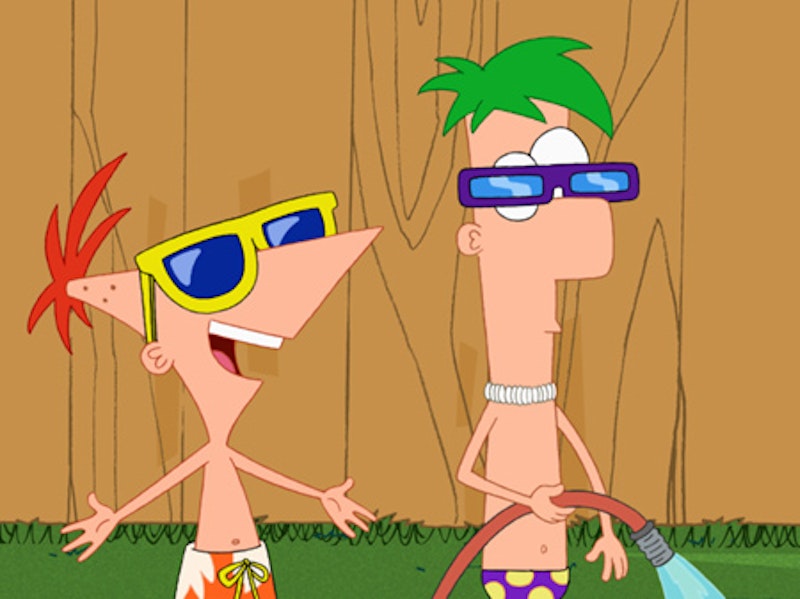Classic cartoons feature protagonists with direct, clear-cut motives and wants. On Tom & Jerry, Tom wants to eat Jerry; Jerry lives to antagonize Tom. On G.I. Joe, Cobra wants to conquer the world; G.I. Joe’s purpose is to hinder Cobra. On Dora the Explorer, the titular cutie-pie wants to have fun and help strangers. By this logic, Phineas & Ferb is complicated: the program stuffs several series’ worth of plots and relationships into brisk, deadpan 15-minute chunks that are eminently re-watchable. Its characters are all bug eyes, caricature sharp edges, and self-aware quips. Its myriad plot elements eventually converge neatly, a la Seinfeld. It’s my four-year-old son’s favorite show right now, and try as I might, I can’t get sick of it.
Phineas & Ferb—the former is talkative and red-haired, the latter mostly mute, with a green mop—are stepbrothers who seem to be stuck in an endless middle-American suburban summer. Every day, the boys throw themselves into one impossible scheme or another, usually in their oversized backyard: building a rollercoaster, opening a restaurant, getting a blimp airborne, traveling through time, flying themselves and their pals around the world, building clones of themselves to complete all the schemes they haven’t had time to complete. In a twist on likely influence Calvin & Hobbes, these exploits actually happen. The brothers’ motive, then, is clear: they’re drolly battling boredom. As if this wasn’t enough, there are several ancillary characters whose desires conflict with or intersect with the protagonists’. Candace, the sister, wants their parents to catch the boys in the act—but she also wants to make time with her dreamboat boyfriend, Jeremy. Perry, the boys’ pet platypus, is a secret agent who descends into a high-tech complex below the family home; his aim is to foil whichever nefarious activity Dr. Heinz Doofenshmirtz happens to be engaged in. Doofenshmirtz, a voluble, lab-coated geek with a generic Euro-baddie accent, scans as a sort of bargain basement Dr. Evil; he’s not trying to conquer the world—he just wants to rule the tri-state area. Perry and Doffenshmirtz, whose relationship is more co-dependent than antagonistic, usually wind up battling it out and destroying whatever contraption Phineas and Ferb have built mere seconds before Candace can show it to their mother. So in Phineas & Ferb, all the elements necessary to woo pre-teen boys are present: a premium is placed on the power of imagination, a mean older sibling who never quite manages to get the younger kids in trouble, an unlikely pet who happens to have the sort of thrilling post-007 inner life most fifth-graders would kill for.
Yet almost as an afterthought, the series hits a number of sour socio-economic notes that root in the recessionary present. In the real world, the visionary and outlandish ideas Phineas and Ferb think up and actualize would theoretically be worth millions, but ultimately wind up being used as a means of entertaining themselves and their motley crew of friends; in this sense, they’re like talented bloggers or hobbyists who can’t land proper jobs. Doofenshmirtz may be an evil genius with a downtown high rise bearing his name, but he lacks minions or assistants; like many contemporary entrepreneurs, he has to draft and execute his dastardly deeds by his lonesome. (In more recent episodes, it’s revealed that he charges his supply costs to his ex-wife’s credit card.) Presumably, Phineas and Ferb are at home all summer because the family can’t afford to send them to camp. And because someone has to watch the title characters while Mom tootles around town and Dad works, high-school age Candace can’t devote herself to a job. The secret organization that Perry spies for appears to consist of Perry, Carl the Intern, and Major Monogram, who gives Perry his marching order. How perfect a microcosm is this of the new world order, with its skeletal staff and cost-cutting measures - even at the risk of reduced security? It’s difficult to say whether the show’s creators are holding a mirror up to reality or offering a sly commentary on it; either way, their willingness to inject subversion into an already complicated show is worthy of applause.
Phineas & Ferb's Bittersweet Technicolor Dialectic
The Seinfeld of kids programming.

